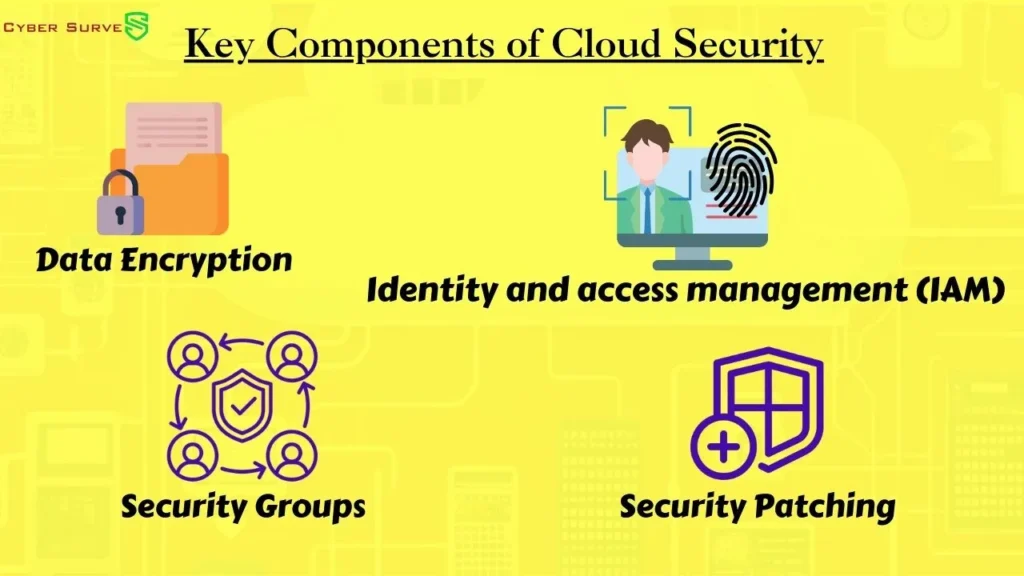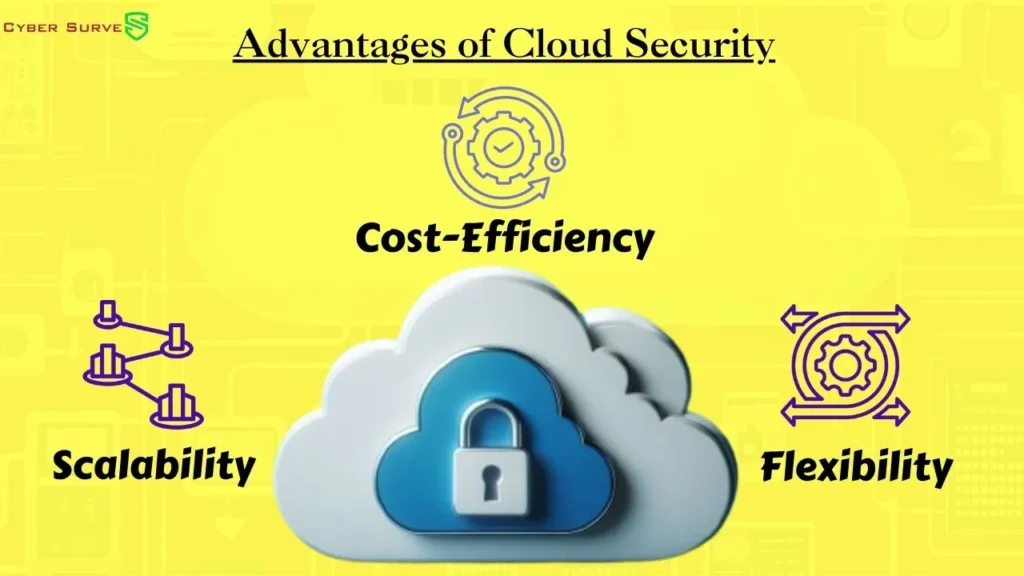Table of Contents
ToggleIntroduction
Cloud security has become an essential part of organizations’ digital infrastructure, ensuring the protection and integrity of data stored in the cloud. But what exactly is Cloud Security and why Cloud Security is important for an organization’s success?
Definition of Cloud Security
Cloud security refers to the set of policies, technologies, and controls implemented to protect data and applications stored in the cloud from unauthorized access, data breaches, and other security threats. It encompasses various measures, including data encryption, identity and access management, security groups, and security patching, to ensure the confidentiality, integrity, and availability of cloud-based resources.
Growing Significance
As organizations increasingly migrate their critical data and applications to the cloud, the significance of cloud security has grown exponentially. With the rapid adoption of cloud computing, businesses are reaping the benefits of increased scalability, cost-efficiency, and flexibility. However, without proper security measures in place, these advantages can easily be negated by the potential risks and vulnerabilities associated with cloud environments.
Key Components of Cloud Security
To understand the importance of cloud security, it’s essential to examine its key components:
1. Data Encryption
Data encryption plays a vital role in cloud security, ensuring that sensitive information remains confidential even if it falls into the wrong hands. By encrypting data before it is stored in the cloud and decrypting it only when necessary, organizations can maintain the privacy and integrity of their data.
2. Identity and Access Management (IAM)
IAM allows organizations to control and manage user access to cloud resources. By implementing strong authentication and authorization mechanisms, organizations can ensure that only authorized individuals can access and modify sensitive data stored in the cloud.
3. Security Groups
Security groups act as virtual firewalls that monitor and control incoming and outgoing traffic to cloud instances. By defining specific rules and policies, organizations can effectively safeguard their cloud resources from unauthorized access and potential security threats.
4. Security Patching
Regular security patching is crucial to protect cloud environments from known vulnerabilities and exploits. By promptly applying patches and updates to their cloud infrastructure, organizations can reduce the risk of cyber-attacks and maintain a robust security posture.

Advantages of Cloud Security
Implementing robust cloud security measures offers several advantages for organizations:
1. Scalability
Cloud security allows organizations to scale their resources according to their needs. Whether it’s increasing storage capacity or bandwidth, cloud security ensures that organizations can seamlessly adapt to changing demands without compromising data security.
2. Cost-Efficiency
Cloud security eliminates the need for expensive on-premises infrastructure and maintenance costs. With cloud-based security solutions, organizations can reduce hardware and software expenditure while still benefiting from robust security measures.
3. Flexibility
Cloud security offers businesses the flexibility to work from anywhere, at any time. With secure access to cloud resources, employees can collaborate remotely, enhancing productivity and efficiency.

Types of Cloud Security Threats
While cloud security offers numerous benefits, organizations must also be aware of the various threats they may face:
A. External Threats
1. Malware Attacks
Malware attacks, such as viruses, worms, and ransomware, pose a significant threat to cloud environments. These malicious software programs can infiltrate cloud infrastructure and compromise sensitive data.
2. DDoS Attacks
Distributed Denial of Service (DDoS) attacks overload cloud servers with an overwhelming amount of traffic, rendering them inaccessible to legitimate users. These attacks can disrupt business operations and result in financial losses.
B. Internal Threats
1. Insider Threats
Insider threats involve individuals within an organization who misuse their access privileges to steal or manipulate data. These threats can have severe consequences, leading to data breaches and reputation damage.
2. Data Leakage
Data leakage occurs when sensitive information is unintentionally or maliciously exposed to unauthorized individuals. This can happen due to misconfigurations, weak security controls, or human error.
Cloud Security Standards and Compliance
To ensure the effectiveness of cloud security measures, several industry standards and regulatory compliance frameworks have been established:
Overview of Industry Standards
Industry standards, such as ISO 27001 and NIST SP 800-53, provide organizations with guidelines and best practices for implementing comprehensive cloud security controls. These standards help organizations achieve a higher level of security and mitigate potential vulnerabilities.
Regulatory Compliance in Cloud Security
Cloud security is closely regulated to protect sensitive data in various industries. Two prominent regulatory frameworks are:
1. GDPR (General Data Protection Regulation)
The GDPR applies to organizations handling the personal data of EU citizens. It mandates strict requirements for the protection, transfer, and processing of personal data, with severe penalties for non-compliance.
2. HIPAA (Health Insurance Portability and Accountability Act)
HIPAA sets standards for safeguarding protected health information (PHI) in the healthcare industry. It requires organizations to implement stringent security measures and maintain the privacy and confidentiality of patient data.
Cloud Security Technologies
To address the evolving threat landscape, several advanced technologies are used in cloud security:
1. Firewalls and Intrusion Detection Systems (IDS)
Firewalls and IDS play a crucial role in preventing unauthorized access and detecting suspicious activities within a cloud environment. They monitor network traffic, block malicious content, and alert administrators to potential security breaches.
2. Security Information and Event Management (SIEM)
SIEM solutions collect and analyze log data from various sources, allowing organizations to detect and respond to security incidents in real-time. They provide comprehensive visibility into cloud environments and enable proactive threat mitigation.
3. Virtual Private Clouds (VPCs)
VPCs create isolated virtual networks within the cloud, providing additional security layers for cloud resources. By separating different components of an organization’s infrastructure, VPCs minimize the risk of unauthorized access and data leakage.

Why Cloud Security Is Important For An Organization
Cloud security is critical in today’s digital environment. Here are the key reasons why organizations should prioritize cloud security:
1. Protection of Sensitive Data
Sensitive data, such as customer information and intellectual property, must be adequately protected from unauthorized access. Cloud security measures ensure that this data remains confidential and is not compromised by cybercriminals.
2. Ensuring Compliance
Many industries have specific regulatory requirements that organizations must comply with to protect sensitive data. There may be harsh fines and reputational harm if these compliance requirements are not met. Cloud security helps organizations meet these requirements and maintain regulatory compliance.
3. Safeguarding Against Cyber-Threats
Cyber-threats are evolving rapidly, and organizations must stay ahead of potential security breaches. Robust cloud security measures provide protection against malware attacks, DDoS attacks, and other cyber threats, ensuring the integrity and availability of cloud resources.
4. Ensuring Business Continuity
Data breaches and security incidents can disrupt business operations and lead to significant financial losses. Cloud security measures help organizations mitigate the impact of such incidents, ensuring business continuity even in the face of security threats.
Best Practices for Cloud Security
To enhance cloud security, organizations should follow these best practices:
1. Conduct Regular Risk Assessments
Regular risk assessments help identify vulnerabilities and weaknesses in cloud environments. By understanding potential risks, organizations can implement appropriate security measures to mitigate these threats effectively.
2. Employee Training and Awareness
Employees are essential to protecting cloud security. Regular training and awareness programs help educate employees about the importance of security policies, safe data handling practices, and potential security threats.
3. Implement Strong Identity and Access Management
Strong authentication mechanisms, robust access controls, and regular access reviews are essential for ensuring that only authorized individuals can access sensitive data stored in the cloud.

Cloud Security for Different Industries
Cloud security is vital across industries, but some sectors face specific security challenges:
1. Healthcare
The healthcare industry deals with sensitive patient information and is subject to strict regulatory requirements. Robust cloud security measures help healthcare organizations maintain the privacy and confidentiality of patient data.
2. Finance
Financial institutions manage huge amounts of confidential client information. Cloud security plays a critical role in protecting this data from cyber-criminals and ensuring compliance with financial regulations.
3. E-commerce
E-commerce businesses rely heavily on cloud infrastructure to process transactions and store customer data. Cloud security measures protect customer information, safeguard financial transactions, and prevent data breaches.
Emerging Trends in Cloud Security
Cloud security continues to evolve to address emerging threats and challenges. Here are some notable trends:
1. Zero Trust Security Model
The Zero Trust security model assumes that no user or device can be trusted, even if they are within the organization’s network perimeter. This approach focuses on continuous verification, authorization, and monitoring of user activities to enhance cloud security.
2. Artificial Intelligence in Cloud Security
AI-powered security solutions can analyze vast amounts of data, identify patterns, and detect anomalies in real-time. They enhance threat detection and response capabilities, making cloud security more proactive and effective.
3. Quantum Computing Threats and Protections
As quantum computing advances, it poses new challenges to cloud security. Quantum-resistant encryption and quantum-safe algorithms are being developed to ensure the long-term security of cloud-based data and applications.
Conclusion
Cloud security plays a critical role in ensuring the confidentiality, integrity, and availability of data and applications stored in the cloud. By implementing robust security measures, organizations can protect sensitive information, comply with regulatory standards, safeguard against cyber threats, and ensure uninterrupted business operations. With emerging trends and evolving technologies, cloud security continues to adapt to the ever-changing threat landscape, making it an essential aspect of organizational success.
FAQ’s
Without adequate cloud security, organizations are vulnerable to data breaches, unauthorized access, data loss, compliance violations, and reputational damage.
Cloud security measures such as encryption, access controls, multi-factor authentication, and regular security audits help safeguard sensitive data from unauthorized access or theft.
Best practices include implementing strong authentication methods, regularly updating software and patches, conducting security training for employees, monitoring network traffic, and using encryption for data at rest and in transit.
Strong cloud security measures help organizations comply with regulations such as GDPR, HIPAA, PCI DSS by ensuring the protection of sensitive data and maintaining data privacy.
Thank You
I hope this article is of interest to you and that you are doing well. If so, please leave a comment and tell your friends and colleagues.


Pingback: What is Cybersecurity? - Cyber Surve
Pingback: What are The 3 Elements of Network Security? - Cyber Surve